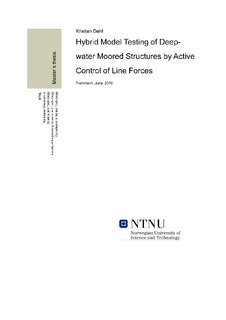| dc.description.abstract | Increased activity in deeper water areas, in connection with oil and gas exploration, has resulted in a steadily increased demand for model testing technology to predict reliable behavior of floating offshore structures at deep water. Common model testing technology, developed for more shallow water, must be modified to meet the challenges that deep water model testing poses. The approach using active control of line forces to replace the mooring and riser system seems promising. Actuators should induce the same resulting forces as calculated by numerical methods on to the vessel in real time.
This master’s thesis has its focus on the development of an experimental setup to investigate the performance of the control system inducing desired forces on to a simplified vessel model. To simplify the complexity with an experiment using a vessel moving in 6 degrees of freedom (DOF), a simplified vessel model with motion only in the heave direction is considered. Active control of the line force connected to the vessel, moving only in heave direction, is launched to investigate if the actuator or motor-winch system, mange to induce the correct calculated mooring force for a measured heave motion.
Necessary procurement of parts to the experimental setup has been obtained. Reasonable values for the maximum and minimum top tension for one mooring line has been used to find an appropriate actuator. A Faulhaber electrical motor was chosen to meet the specifications. The drive electronics controlling the electrical motor has a wide variety of control options, and control of the motor shaft torques, necessary to obtain desired forces, is possible.
A mathematical model describing the experimental setup was developed. A model of the DC motor dynamics and the mass dynamics are mathematically derived. The unknown parameters in the model have been found using measurement data from experiment. The measurement data are established using a pretensioned spring connected to the DC motor shaft, as well as a freely running shaft.
In the experiments two test cases are considered. In test case one a spring and line, representing the active mooring line, is connected in-between the vessel model, or oscillating actuator, and a motor-winch system. The motor-winch, or DC motor, will then try to pull the line and spring till it reaches the desired reference. The measured heave motion to the oscillating system is utilized to calculate the mooring force references, the active mooring line will then try to induce the same forces as calculated. The calculated forces are only available for a given heave motion.
A second test case is performed with a vessel model represented as a mass. The mass, or vessel, is connected to the oscillating system actuator with a spring. The oscillating system actuator will represent the wave motion, while the spring should represent the water plane stiffness. A rope, or line, connected in-between the mass and the motor-winch system will represent the active mooring line. Different sinusoidal references, as well as piecewise constant signals are used to test if the active mooring line is able to induce the desired forces on to the mass real time.
The results show that for the given heave motion the motor-winch setup will be able to actuate the desired mooring line forces on to the oscillating body. Sinusoidal force references are also possible to follow. There is however a constraint in the frequency, and a high oscillating system frequency will be a limitation. By decreasing the oscillating frequency less noise in the measured signal will occur.
To avoid a lot of noise in the measured forces filtering the signal was necessary. An observer has been developed to remove this noise. The filtered signal (estimated force) can then be used as feedback to the controller.
A vessel model considered in three DOF is used to find an appropriate sampling frequency. The real time response measurements to the vessel need to be sampled in order to calculate desired mooring forces. A study is therefore conducted to find the bandwidth, or highest frequency, in the system to conclude which sampling frequency that is needed to recreate the response signals without loss of information. The results show that 50 Hz sampling frequency will be necessary to recreate the continuous time signals for the specific case considered. | nb_NO |
